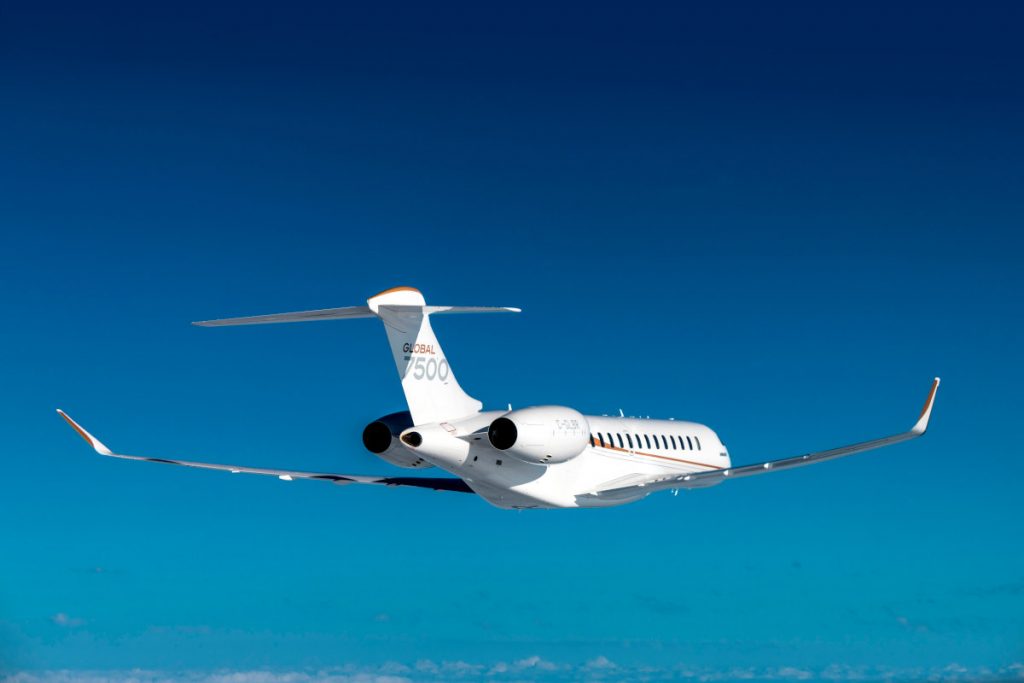
Features
Aircraft manufacturers
CBAA Ontario chapter outlines priorities, tours Bombardier’s Pearson facility
April 9, 2024 By Phil Lightstone
 Bombardier Global 7500. (Photo: Bombardier)
Bombardier Global 7500. (Photo: Bombardier) The Ontario chapter of the Canadian Business Aviation Association on April 4 gathered at Bombardier’s new manufacturing facility at Toronto Pearson Airport for its quarterly meeting. The event was sponsored by Bombardier, Signature Aviation and Echo Aviation Leasing. A highlight of the meeting was a guided tour of Bombardier’s state-of-the-art aircraft manufacturing facility, with more than 178,000 square feet of space.
Ehsan Monfared, Chair of the Canadian Business Aviation Association (CBAA) and Partner at YYZ Law, kicked off the event delivering a message regarding the CBAA’s ongoing interactions and education with MPPs and MPs pertaining to the importance of Business Aviation (BA) to the Canadian economy and the impacts of the Luxury Tax.
“We consistently received comments from MPPs and MPs in part communicating that they did not know who the CBAA was within the aviation ecosystem,” said Monfared. “These decision and policy influencers and makers were not necessarily educated to the outcomes of policy. It’s critical that CBAA members communicate and educate their MPs and MPPs.”
Anthony Norejko, President and CEO, CBAA delivered a presentation to the attendees touching on a variety of topics including: the Luxury Tax; the impact of change in the industry (using Newton’s second law of motion) where change = Members * Association); impact of construction activities at Canada’s four major airports (CYYZ, CYUL, CYYC and CYVR); and Transport Canada initiatives.
“The change we want to see requires the members and our association to work together to educate and influence government,” said Norejko. “The chapter event at Bombardier’s Global completion centre was the perfect backdrop to demonstrate why we remain committed to the industry and the Canadians employed by Business Aviation across the country.”
Pierre Pyun, VP of Government and Industry Affairs at Bombardier, provided an in-depth introduction to Bombardier’s global initiatives and Canadian activities. Pyun touched upon a March 2022 Price Waterhouse Coopers (PWC) report called The Economic Footprint of Bombardier’s Activities 2021-2025 which quantifies the importance of Canadian Aerospace manufacturing to the Canadian economy. Bombardier has: 18,100 employees, of which 11,800 are in Canada with 2,100 in Ontario; 2023 revenue exceeding US$8 billion and 20 per cent EBIDTA; a goal to reach US$9 Billion in revenue by 2025; and two manufacturing sites in the U.S. and two in Canada.
Pyun noted that Bombardier’s operations in Canada contributes $5.7 billion to Canada’s Gross Domestic Production (GDP), while providing employment for more than 33,000 people (inclusive of third party suppliers). Bombardier purchases over $843 million worth of products and services from Ontario suppliers. The message which Pyun delivered highlighted the economic benefit which Bombardier provides both on Ontario and Canada as a whole. Information was provided about Bombardier’s Net Zero carbon initiatives as well as its utilization of SAF fuels.
Pyun also provided a briefing regarding the impact of the Luxury Tax to Bombardier, as well as the Canadian aviation ecosystem. The impact of the Luxury Tax appears to have influenced the loss of 3,800 Canadian jobs and $1.1 billion in lost revenue by March 2023. The tax contradicts Canada’s carbon neutral policies, while U.S. competitors are using the added burden of the Luxury Taxes as a competitive advantage to entice Canadian buyers to purchase U.S. registered aircraft and hold them in U.S. corporations, contributing to the decline of BA aircraft in Canada.
Bombardier has recommended to the Federal government that the business-use exemption threshold be lowered from 90 per cent to 50 per cent, to be more reflective of the utilization of the BA sector. Bombardier feels that the cost benefit of the tax no longer makes sense based upon the current statistics; and while the politicians fulfill a champaign promise to tax the rich, they should = take a different view based upon the actual impacts of the tax.
At the conclusion of the meeting, the attendees were divided into nine groups for a guided tour of Bombardier’s new manufacturing facility at Toronto Pearson Airport, CYYZ. The new facility resides on 42 acres on the north side of CYYZ and is state of the art from a manufacturing technology, people and process perspective. Using a “station” approach to the airframe build-up process, and depending upon the aircraft model, eight or nine stations are employed for airframe building, with each aircraft spending roughly five days in each station.
Aircraft subassemblies, such as wings, tails, fuselage sections, are assembled and inspected beginning with the fuselage subassemblies, at each station. As the aircraft moves from station to station, other components like engines and control surfaces are added to the aircraft. Bombardier has implemented a new tool caddy which is has a transparent cover and markings for each tool. At the end of a shift, each technician will bring the tool back to the caddy. This approach allows the team to visually inspect and confirm that all tools have been returned, minimizing (if not eliminating) Foreign Object Debris (FOD) during the build.
Of note was both the amount of light and cleanliness of the floor and work environment. Aircraft spend roughly 45 days in the plant, before being rolled out for flight testing and a ferry flight to Montreal (for paint and interior finishings).
“The event was one of the best attended chapter events in recent history,” said Andy Nureddin, Vice Chair, CBAA. “The tour of the Bombardier factory highlighted the capabilities of Canadian aviation manufacturing and the expertise and proficiency of the Canada’s aviation skilled workforce.”